Menus
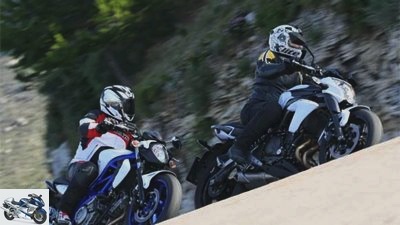
Blacksmith
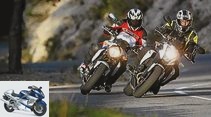
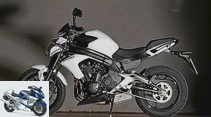

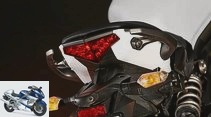
16 photos
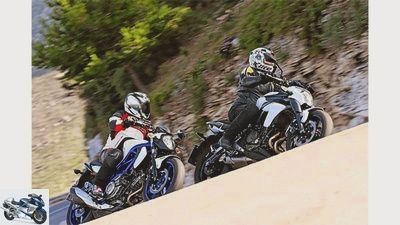
Jahn
1/16
Suzuki Gladius and Kawasaki ER-6n in comparison test. Which of the 650 twin-cylinder has the edge in the end?
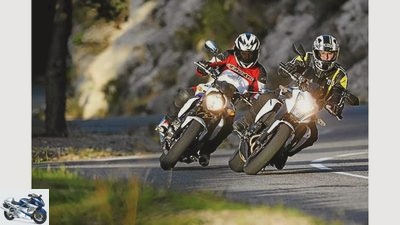
Jahn
2/16
Machines for beginners? Also, but not only. They even make professionals happy.
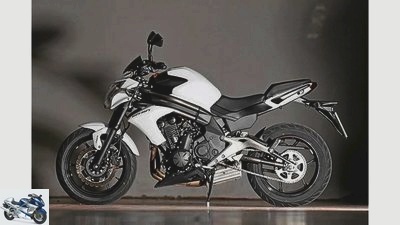
Jahn
3/16
Kawasaki ER-6n – easy to see in the overall view (center): “Camel hump tank”, “bread box silencer” under the engine and two-part seat.
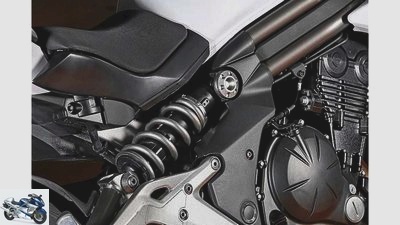
Jahn
4/16
The exposed strut remains characteristic: directly hinged and easily accessible because it is off-center to the right. The bridge frame made of two parallel steel tubes is new, now without the former joists on the side of the engine.
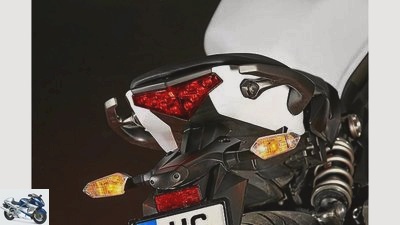
Jahn
5/16
At the rear taillights with maintenance-free LEDs at the Kawa.
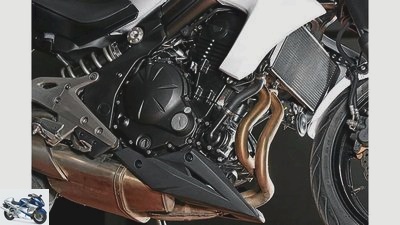
Jahn
6/16
Exquisite: the exhaust system made entirely from stainless steel from the series win from Kawasaki. The silencer got new cats, the funnel-shaped extension on the right front increases the volume compared to the previous model. New: interference tube between the jagged bends.
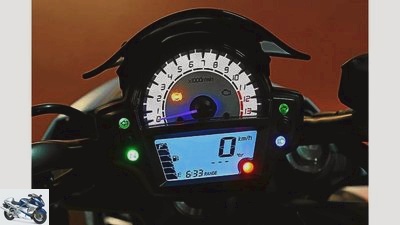
Jahn
7/16
ER-6n: clearly structured and equipped with an on-board computer: new instruments. Only the speedometer is too low.
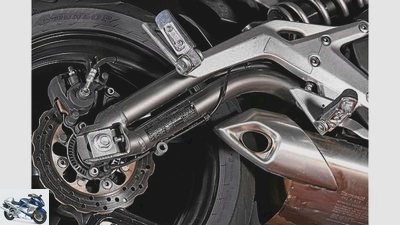
Jahn
8/16
Double tube banana swing arm with fine dropouts and chain tensioners on the Kawa.
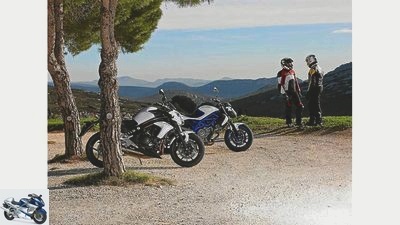
Jahn
9/16
The 650s also look sporty when stationary.
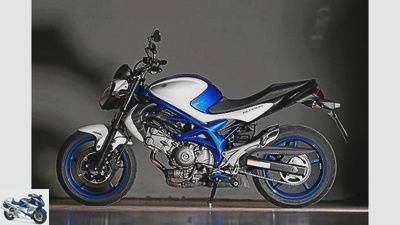
Jahn
10/16
Suzuki Gladius.
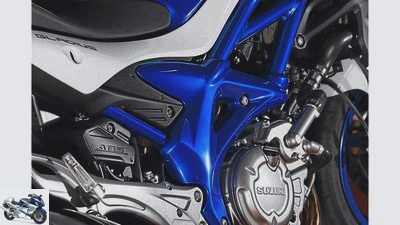
Jahn
11/16
Suzi is made up in two-tone paint. Painted plastic covers sit over the steel tubular frame. It is praiseworthy that the Suzuki also has ABS as standard equipment – the control unit is located above the right footrest bracket. As with the ER-6n, it is made in one piece. Individual and innovative: plastic panels in front of the tank flanks protect the fuel container if it falls over.
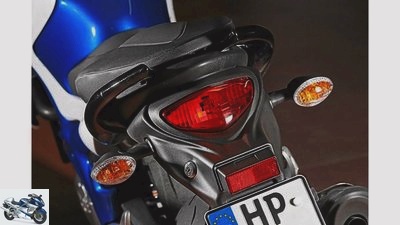
Jahn
12/16
A conventional lamp glows out from the back of the Suzuki.
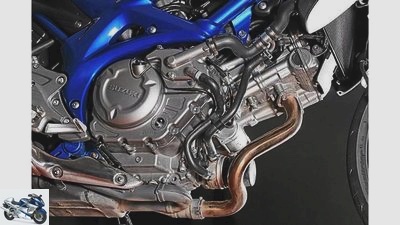
Jahn
13/16
This even externally shiny 90-degree V2 of the Gladius continues to inspire. The momentum in the front manifold adjusts its length to the rear colleague in a way that promotes torque. And it makes it easier to remove the oil filter, as with the ER-6n.

Jahn
14/16
Easily readable instruments, the Gladius has a practical gear indicator in the rev counter.
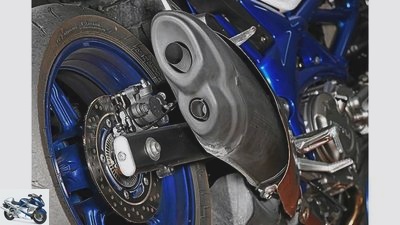
Jahn
15/16
Just like the collector under the engine, the curved silencer on the Suzuki is made of simple, black painted steel. The swing arm and chain tensioner also look cheap.
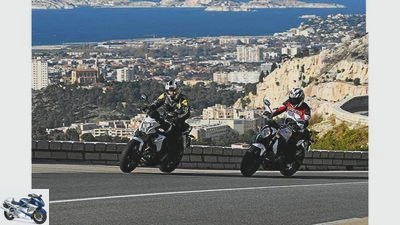
Jahn
16/16
City, country, river – sorry: sea. The lively 650s do everything. In the end, the Kawasaki has the edge.
Comparison test: 650 twin-cylinder
A comparison of naked bikes from Suzuki and Kawasaki
With these 650 twins, a dream vau meets a double-breasted suit, feminine, gentle curves compete with a muscular, wiry appearance. Regardless of the differences, both 72 HP flyweights offer ABS and a lot of driving pleasure for 7000 euros.
It’s like a mouse-milk: the tax office puts pressure on the tax return, the teenage son can’t find a job because he dies and the boss is asking too much again. Great. But now they can definitely do you. An azure blue sky with snow-white fleecy clouds stretches over you. Below you is a fine two-cylinder hammering its bassy beat. Let’s get out. The lights of the big city glow in the mirrors. The Kawasaki ER-6n, which was heavily redesigned in 2012, and the well-known Suzuki Gladius are excellent escape helpers from everyday life.
Here in the south of France, the Mediterranean sun bathes pine, palm and plane trees in golden light. But only a few more weeks and oaks, ash trees and alders bloom at home. A good prospect of shoving these two friendly all-rounders out of the garage. Your driving motto is good for personals: everything can, nothing has to. This unites the two 650s in all disputed questions of faith: V2 or in-line engine, feminine curves or masculine-muscular demeanor?
Okay, the name Gladius, it denotes a short sword used by Roman legionaries, makes it difficult to be martial. But does that fit? Where the whole motorcycle is more of a single, gently flowing design wave? Round shapes, covers made of plastic and chrome-plated sheet metal over the tank, frame and exhaust. The tubular space frame, like the rims, is painted blue. Suzi likes makeup. The ER-6n is more jagged, futuristic and wiry. The 2012 model of the Kawasaki looks more distinctive than ever. Well-known basic forms, just sharper, more adult.
Buy complete article
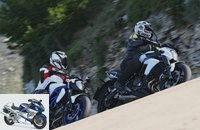
Comparison test: 650 twin-cylinder
A comparison of naked bikes from Suzuki and Kawasaki
Jahn
City, country, river – sorry: sea. The lively 650s do everything.
As such, double throttle valves, as in the Kawasaki series twin, are supposed to optimize the flow in the intake tract: The driver opens the primary throttle valve between zero and 90 degrees, the on-board computer then adjusts the opening angle of the secondary throttle valve. This should improve the throttle response (Suzuki advantage) and minimize load change reactions. The Kawa twin can do that better.
Subjectively, the inspiring Suzuki twin feels more airy and powerful. No other engine up to 650 cubic meters shakes its power out of its sleeve so easily! If you think you are in third gear, fourth is already there, as the exclusive gear display reveals. Suzi storms carefree forward, accompanied by Ducati-like V2 staccato. This soul flatterer pulsates very gently. And for all its liveliness, it is even more economical than the Kawa. No wonder that the Traum-Vau is also allowed to fire up the brilliant V-Strom 650. Powerful and strong in character, V2 engines have a long tradition at Suzuki.
HE has a slightly different nature. Unpolished, wilder, more masculine. The twin vibrates harder. Its pistons whiz up and down in opposite directions. After a cold start, it turns up quite high for a long time when idling. Despite the large flywheel mass, the black painted Kawa power source requires higher speeds in the upper gears than the Suzuki: It does it from 2000 rpm, ER smoothly from 3000 rpm. The Kawa twin feels more comfortable in the second half of the speed. It is more important to stir in the hard-shifting ER gearbox in order not to lose touch. There is an audible limbering from the kawa aisle box.
A robust engine with the same intake noise: the new model slurps for air between the parallel frame tubes. And, as usual, puffs out deeply grumbling through the underfloor exhaust. In contrast to that of the Suzuki, it is made entirely of stainless steel and is now a little steeper towards the rear. In 2012, more exhaust volume plus modified inner workings and new software should make the torque of the unchanged engine fuller. But the result is sobering: the previous model was beefier, more powerful. The update is a step backwards here.
Now the Kawasaki can no longer trump the Suzuki at any speed. It also turns more slowly than the Gladius, looks more strained. But without the direct comparison to the V2, the in-line twin is also a great engine. ER-6n and Suzuki Gladius are machines with proven stable engines. You clear your head, you never stress.
But despite the 34 hp option – just don’t misunderstand the “entry-level motorcycles”: 72 hp is more power than the Honda CB 750 Four motorcycle of the century ever had. This enables high propulsion. At least when combined with just 208 kilograms for the Kawasaki and only 206 kilograms for the Suzuki.
From zero to one hundred in less than four seconds, ten seconds in sixth gear from 60 to 140, that’s faster than a Porsche! And even big bikes rarely use more than real 75 hp from the Suzuki and 73 from the Kawa on country roads. If only it weren’t for the regulars’ table. Those who renounce performance mania do not need a loan with special conditions at prices hardly over 7000 euros.
Jahn
Suzuki Gladius.
The bottom line that the Kawasaki outperforms the Suzuki in terms of driving fun is due to its revised chassis. The steel bridge frame now consists of parallel tubes, fine and stable. Front and rear, the suspension travel increased by five to 125 and 130 millimeters, exactly the Gladius level. This made softer springs possible with adapted damping. Fits. With sleepwalking confidence, ER finds the right line, remains more precise, more relaxed, more neutral. The fork responds finer, the directly hinged shock absorber offers enough reserves. HE simply strikes even more jagged, tighter hooks than “you”. Fine.
The Suzuki needs a little more emphasis to stay on the line. By itself, the gladius tends to have slightly wider arches. There is always more movement in their chassis. With bumps in curves or load changes in an inclined position, a real jolt goes through the motorcycle. It feels like “caving in.” Madame wriggles and kinks. No wonder, with the soft strut. It pumps with a forced driving style. Its rebound stage is underdamped, it rebounds too quickly after compression. And with a pillion, Suzi slumped a lot.
The Dunlop qualifiers of the Suzuki roll extremely numbly on the wet road or when heating on a dry road surface. As if running on raw eggs. He drives the famous, brand new Dunlop Roadsmart II much safer: it circles corners more confidently, adheres much better, conveys more confidence. Extremely important for motorcycles that are intended to satisfy beginners and veterans alike.
A huge pound is ABS as standard on both sides. In 2012, the ER carries a new, more precisely regulating control unit from Bosch. The rear wheel now remains close to the ground at the front even when you keep it completely clean. Brake discs with a typical Kawa serrated edge are supposed to improve the heat and, if necessary, the water drainage.
The savings dictate is noticeable in the simple brake calipers: double-piston floating calipers at the front, single-piston floating calipers at the rear. Less is hardly possible. These pliers need some temperature, so several attempts to build up a good delay. With the Suzuki, the controllability should be better, the front brake looks doughy.
And the feeling of sitting? On the Kawasaki, it sits closer to the front wheel. More modern, more compact, more assembled. But maybe too sporty for some drivers. One advantage over the previous model is the two centimeters wider handlebar. You feel more classically accommodated on the Gladius. Just a little more passive. The footrests are a little high here and there and quite far forward. This results in an acute knee angle for long-legged people.
Jahn
Kawasaki ER-6n – easy to see in the overall view (center): “Camel hump tank”, “bread box silencer” under the engine and two-part seat.
Conversely, small pilots find a safe footing with both. Narrow cut of the bench in the front area makes it possible. As of 2012, the Kawa seating furniture has been divided into two parts, more comfortable because it is thicker upholstered and contoured more carefully. The new frame makes the Kawasaki waist narrow like a wasp: the steel tubes in the middle lead far inwards; the rear branches off to the rear as a welded central tube with a flanged passenger carrier. Now the payload has increased to 198 kilograms. Suzi saddles even more (214 kg).
When it comes to workmanship and equipment, ER is one step ahead – adjustable clutch lever, luggage hook, on-board computer. The 42,000 valve clearance and 12,000 oil change intervals are great. Inexpensive and good. The Suzuki is more expensive to buy and maintain. Praiseworthy: Kawasaki has not increased the price of the new ones. It’s about something: For years, the 650 built in Thailand, in conjunction with its half-faired sister ER-6f, has been the best-selling Kawasaki in Germany – overall in third place in 2011! Over 60,000 copies of the lively Kawa have found buyers in Europe since 2005. The improved 2012 model will build on this. The Gladius is also a top seller, taking second place behind the Bandit 1250 in the Suzuki ranking in Germany.
What if you had one wish? Besides a more understanding tax office, a job for the son and a more patient boss? Clearly: the exciting Suzuki V2 in a Kawasaki chassis. That would be the perfect mid-range machine. Until then, both offer ideal country road engines with feminine or masculine charms. A great and inexpensive relaxation and wellbeing program.
MOTORCYCLE scoring / test result
Jahn
The 650s also look sporty when stationary.
engine
Clear case: The Suzuki V2 is top. It feels beefier than the in-line engine, vibrates less and revs up more freely. On the plus side, there are better torque values in sixth gear and finer throttle response. Only the load change reactions are more pronounced. Kawasaki’s row twin in the ER-6 runs rougher, requires more manual work. So it’s a bit of a shame that the Kawasaki gearbox shifts hard and loud, and that the clutch can’t be adjusted so finely.
Winner engine: Suzuki
landing gear
The hour of the ER-6n. Your chassis remains much more stable under all circumstances, and curves around it more precisely. In addition, it drives a bit more manageable and is blessed with more feedback such as freedom from lean angles. With this good basic set-up, you can get over the marginal adjustment options of the chassis. Gladius rolls through life softer but also more spongy. Your shock absorber is no match for bad roads or a pillion passenger.
Chassis winner: Kawasaki
everyday life
Advantage Kawasaki. The new, two-part seat offers a more comfortable pillion seat. Both machines are tailored towards smaller drivers at the front. The ER-6n leads the way in terms of equipment: both hand levers are adjustable, an on-board computer is standard, and the rear is equipped with luggage hooks. Their stacked headlights emit brighter, less blotchy light. The Gladius saddles even more than the Kawa: payload 214 instead of 198 kilograms.
Winner everyday: Kawasaki
security
The new Kawa-ABS is paying off. The Bosch control unit regulates well. The ER-6n is slightly above the Suzuki Gladius in terms of braking effect and dosage. Their front stopper can be dough dosed. A little more protection against unpleasant ground contact is only little consolation.
Safety winner: Kawasaki
costs
Either way: with a mobility guarantee and lower fuel consumption, the Gladius compensates for the cheaper inspection costs of the Kawasaki.
Winner Cost: Tie
Price-performance
It pays off that Kawasaki is not offering the heavily redesigned ER-6n more expensive than its predecessor.
Price-performance winner: Kawasaki
| Max points | Kawasaki | Suzuki | engine | 250 | 140 | 152 |
| landing gear | 250 | 161 | 144 | everyday life | 250 | 135 | 128 |
| security | 150 | 97 | 92 | costs | 100 | 64 | 64 |
| Overall rating | 1000 | 597 | 580 | placement | 1. | 2. |
| Price-performance note | 1.0 | 1.6 | 1.9 |
Jahn
Machines for beginners? Also, but not only. They even make professionals happy.
MOTORCYCLE test result
1.Kawasaki ER-6n
The chassis and ergonomics are clearly improved in 2012. In addition, the Kawa now looks more valuable for the same price. Only with the engine did the facelift bring nothing.
2. Suzuki Gladius
Your V2 is a splendor. Nevertheless, the Gladius could use fine-tuning. Your driving behavior is more nervous, the shock absorber is underdamped, the processing is simple, the equipment is rather sparse.
Jahn
Exquisite: the exhaust system made entirely from stainless steel from the series win from Kawasaki. The silencer got new cats, the funnel-shaped extension on the right front increases the volume compared to the previous model. New: interference tube between the jagged bends.
Kawasaki ER-6n
engine
Water-cooled two-cylinder four-stroke in-line engine, a balance shaft, two overhead, chain-driven camshafts, four valves per cylinder, bucket tappets, wet sump lubrication, injection, Ø 38 mm, regulated catalytic converter, 336 W alternator, 12 V / 14 Ah battery, mechanically operated multi-disc oil bath clutch , Six-speed gearbox, O-ring chain, secondary ratio 46:15.
Bore x stroke 83.0 x 60.0 mm
Cubic capacity 649 cm³
Compression ratio 10.8: 1
rated capacity 53.0 kW (72 hp) at 8500 rpm
Max. Torque 64 Nm at 7000 rpm
landing gear
Bridge frame made of steel, telescopic fork, Ø 41 mm, two-arm swing arm made of steel, spring strut, directly hinged, adjustable spring base, double disc brake at the front, Ø 300 mm, double-piston floating calipers, disc brake at the rear, Ø 220 mm, single-piston floating caliper, ABS.
Cast aluminum wheels 3.50 x 17; 4.50 x 17
Tires 120/70 ZR 17; 160/60 ZR 17
Dunlop Roadsmart II “J” tires tested
Dimensions + weights
Wheelbase 1410 mm, steering head angle 65.0 degrees, caster 110 mm, suspension travel f / h 125/130 mm, seat height * 790 mm, weight with a full tank * 208 kg, payload * 198 kg, tank capacity 16.0 liters.
Two year guarantee
Service intervals 6000 km
Colors yellow, black, white
Power variant 25 kW (34 PS)
price 6,995 euros
Additional costs around 170 euros
Jahn
This even externally shiny 90-degree V2 of the Gladius continues to inspire. The momentum in the front manifold adjusts its length to the rear colleague in a way that promotes torque. And it makes it easier to remove the oil filter, as with the ER-6n.
Suzuki Gladius
engine
Water-cooled two-cylinder four-stroke 90-degree V-engine, transverse crankshaft, two overhead, chain-driven camshafts, four valves per cylinder, bucket tappets, wet sump lubrication, injection, Ø 39 mm, regulated catalytic converter, 375 W alternator, 12 V battery / 10 Ah, mechanically operated multi-plate oil bath clutch, six-speed gearbox, O-ring chain, secondary ratio 46:15.
Bore x stroke 81.0 x 62.6 mm
Cubic capacity 645 cm³
Compression ratio 11.5: 1
rated capacity 53.0 kW (72 hp) at 8400 rpm
Max. Torque 64 Nm at 6400 rpm
landing gear
Steel tubular frame, telescopic fork, Ø 41 mm, adjustable spring base, two-arm swing arm made of steel, central spring strut with lever system, adjustable spring base, double disc brake at the front, Ø 290 mm, double-piston floating calipers, rear disc brake, Ø 240 mm, single-piston floating caliper, ABS.
Cast aluminum wheels 3.50 x 17; 5.00 x 17
Tires 120/70 ZR 17; 160/60 ZR 17
Tires in the test Dunlop Sportmax Qualifier “J”
Dimensions + weights
Wheelbase 1445 mm, steering head angle 65.0 degrees, caster 104 mm, suspension travel f / r 125/130 mm, seat height * 790 mm, weight with a full tank * 206 kg, payload * 214 kg, tank capacity 14.5 liters.
Two year guarantee
Mobility guarantee two years
Service intervals 6000 km
Colors black, black / white, blue / white
Power variant 25 kW (34 PS)
price 7190 euros
Additional costs around 150 euros
Related articles
-
Jahn comparison test Powercruiser Kawasaki VN 2000, Suzuki Intruder M 1800 R, Yamaha XV 1900 Midnight Star Punchtime Nobody distributes more displacement and …
-
Artist comparison test middle class Honda Hornet S Kawasaki ZR-7 S Suzuki GSF 600 S Bandit Yamaha FZS 600 Fazer Born to be mild Four days, 1913 …
-
Honda CBF 600, Kawasaki ER-6n, Suzuki Gladius 650 and Yamaha XJ6
Artist Honda CBF 600, Kawasaki ER-6n, Suzuki Gladius 650 and Yamaha XJ6 comparison test all-rounder Looking for a partner in the world of all-rounders? No…
-
Comparison test of naked bikes BMW R 1150 R Kawasaki ZRX 1200 Suzuki GSF 1200 Bandit
Gragolov Comparison Test Naked Bikes BMW R 1150 R Kawasaki ZRX 1200 Suzuki GSF 1200 Bandit Fat Friends Who upright and unprotected to adventure …
-
Gargolov comparison test big bikes: Honda CBR 1100 XX Super Blackbird, Kawasaki Ninja ZX-12R, Suzuki GSX 1300 R Hayabusa, Yamaha FJR 1300 A Two fast, Two …
-
Comparison test: super sports cars under 1000 cubic meters from MV Agusta, Ducati and Kawasaki
Jahn 46 pictures Jahn 1/46 Kawasaki ZX-6R 636 Jahn 2/46 But the Evo is not alone in this. All three bikes rock the ring during the test. Jahn 3/46 ……
-
Kawasaki 20 pictures Kawasaki 1/20 Kawasaki has given its ER-6 models visual and structural updates for 2012. Kawasaki 2/20 The look of the …
-
Endurance test final balance: Suzuki Gladius
Archive long-term test final balance: Suzuki SFV 650 The 50000 kilometers of the Suzuki Gladius Very few found them beautiful, but with the faithful, Japanese …
-
Comparison test: Ducati Diavel, Suzuki B-King and Yamaha Vmax
Jahn comparison test: Power Bikes 2011 Ducati Diavel, Suzuki B-King and Yamaha Vmax Content from Big appearance, powerful sound waves, pressure from all …
-
Jahn 35 pictures Jahn 1/35 Husqvarna TC 250 R in the motocross comparison test. Jahn 2/35 Yamaha YZ 250 F in the motocross comparison test. Jahn 3/35 Husqvarna TC …